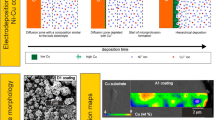Abstract
This research experimentally investigated how the solid fraction level of an array of projecting nickel cylindrical microstructures influenced the electrodeposition of Cu–Ni alloy on the cylindrical microstructures. The electrodeposition of Cu–Ni alloy on a substrate with an array of projecting cylindrical structures resulted in the concentrated precipitation of Cu ions at the top of the cylinders. Relatively more electrodeposited structures were formed at the top surface of the cylinders than at the bottom surface, and electrodeposited structures were not formed at the bottom surface of the substrate when the solid fraction was increased. Structures at the edges of the cylinders’ top surfaces grew larger than the structures at the centers of the surfaces. The heights of the electrodeposited structures decreased as the solid fraction increased. In addition, shadow bands with no electrodeposited structures were observed at the bottom surface of the substrate a certain distance away from the cylinders.








Similar content being viewed by others
References
Shin HC, Dong J, Liu M (2003) Nanoporous structures prepared by an electrochemical deposition process. Adv Mater 15:1610–1614. doi:10.1002/adma.200305160
Li GY, Li XP, Wang H, Yang ZQ, Yao JY, Ding GF (2012) Fabrication and characterization of superhydrophobic surface by electroplating regular rough micro-structures of metal nickel. Microelectron Eng 95:130–134. doi:10.1016/j.mee.2011.12.012
Chen Z, Hao L, Chen A, Song Q, Chen C (2012) A rapid one-step process for fabrication of superhydrophobic surface by electrodeposition method. Electrochim Acta 59:168–171. doi:10.1016/j.electacta.2011.10.045
Michaelis S, Timme HJ, Wycisk M, Binder J (2000) Additive electroplating technology as a post-CMOS process for the production of MEMS acceleration-threshold switches for transportation applications. J Micromech Microeng 10:120–123. doi:10.1088/0960-1317/10/2/304
Ke FS, Huang L, Cai JS, Sun SG (2010) Electroplating synthesis and electrochemical properties of macroporous Sn–Cu alloy electrode for lithium-ion batteries. Electrochim Acta 52:6741–6747. doi:10.1016/j.electacta.2007.04.100
Nikolić ND, Branković G, Maksimović VM, Pavlović MG, Popov KI (2010) Application of pulsating overpotential regime on the formation of copper deposits in the range of hydrogen co-deposition. J Solid State Electrochem 14:331–338. doi:10.1007/s10008-009-0842-1
Lee SM, Jung ID, Ko JS (2008) The effect of the surface wettability of nano protrusions formed on network-type microstructures. J Micromech Microeng 18:125007. doi:10.1088/0960-1317/18/12/125007
Li Y, Jia WZ, Song YY, Xia XH (2007) Superhydrophobicity of 3D porous copper films prepared using the hydrogen bubble dynamic template. Chem Mater 19:5758–5764. doi:10.1021/cm071738j
Ye W, Yan J, Ye Q, Zhou F (2010) Template-free and direct electrochemical deposition of hierarchical dendritic gold microstructures: growth and their multiple applications. J Phys Chem C 114:15617–15624. doi:10.1021/jp105929b
Hu S, Huang W, Li Z (2010) Facile fabrication of 3D dendritic gold nanostructures with an AuSn alloy by square wave potential pulse. Mater Lett 64:1257–1260. doi:10.1016/j.matlet.2010.03.002
Hang T, Hu A, Ling H, Li M, Mao D (2010) Super-hydrophobic nickel films with micro-nano hierarchical structure prepared by electrodeposition. Appl Surf Sci 256:2400–2404. doi:10.1016/j.apsusc.2009.10.074
Gu C, Zhang TY (2008) Electrochemical synthesis of silver polyhedrons and dendritic films with superhydrophobic surfaces. Langmuir 24:12010–12016. doi:10.1021/la802354n
Lee JM, Bae KM, Jung KK, Jeong JH, Ko JS (2014) Creation of microstructured surfaces using Cu–Ni compositeelectrodeposition and their application to superhydrophobic surfaces. Appl Surf Sci 289:14–20. doi:10.1016/j.apsusc.2013.10.066
Qiu R, Zhang XL, Qiao R, Li Y, Kim YI, Kang YS (2007) Cu–Ni dendritic material: synthesis, mechanism discussion, and application as glucose sensor. Chem Mater 19:4174–4180. doi:10.1021/cm070638a
Chang JK, Hsu SH, Sun IW, Tsai WT (2008) Formation of nanoporous nickel by selective anodic etching of the nobler copper component from electrodeposited nickel-copper alloys. J Phys Chem C 112:1371–1376. doi:10.1021/jp0772474
Liu Z, Xia G, Zhu F, Kim S, Markovic N, Chien CL, Searson PC (2008) Exploiting finite size effects in a novel core/shell microstructure. J Appl Phys 103:064313. doi:10.1063/1.2844286
Ollivier A, Muhr L, Delbos S, Grand PP, Matlosz M, Chassaing E (2009) Copper–nickel codeposition as a model for mass-transfercharacterization in copper–indium–selenium thin-film production. J Appl Electrochem 39:2337–2344. doi:10.1007/s10800-009-9918-y
Kim S, Myerson AS (1996) Metastable solution thermodynamic properties and crystal growth kinetics. Ind Eng Chem Res 35:1078–1084. doi:10.1021/ie950327m
Walsh FC, Herron ME (1991) Electrocrystallization and electrochemical control of crystal growth: fundamental considerations and electrodeposition of metals. J Phys D Appl Phys 24:217–225. doi:10.1088/0022-3727/24/2/019
Argoul F, Arneodo A, Grasseau G, Swinney HL (1988) Self-similarity of diffusion-limited aggregates and electrodeposition clusters. Phys Rev B 61:2558–2561. doi:10.1103/PhysRevLett.61.2558
Kaufman JH, Nazzal AI, Melroy OR, Kapitulnik A (1987) Onset of fractal growth: statics and dynamics of diffusion-controlled polymerization. Phys Rev B 35:1881–1890. doi:10.1103/PhysRevB.35.1881
Cassie ABD, Baxter S (1945) Wettability of porous surfaces. Trans Faraday Soc 40:546–551. doi:10.1039/TF9444000546
Jung YC, Bhushan B (2008) Dynamic effects of bouncing water droplets on superhydrophobic surfaces. Langmuir 24:6262–6269. doi:10.1021/la8003504
Acknowledgements
This research was supported by the Pioneer Research Center Program through the National Research Foundation of Korea funded by the Ministry of Education, Science and Technology (2010-0019313).
Author information
Authors and Affiliations
Corresponding author
Rights and permissions
About this article
Cite this article
Lee, J.M., Ko, J.S. Cu–Ni alloy electrodeposition on microstructured surfaces. J Mater Sci 50, 393–402 (2015). https://doi.org/10.1007/s10853-014-8598-0
Received:
Accepted:
Published:
Issue Date:
DOI: https://doi.org/10.1007/s10853-014-8598-0




